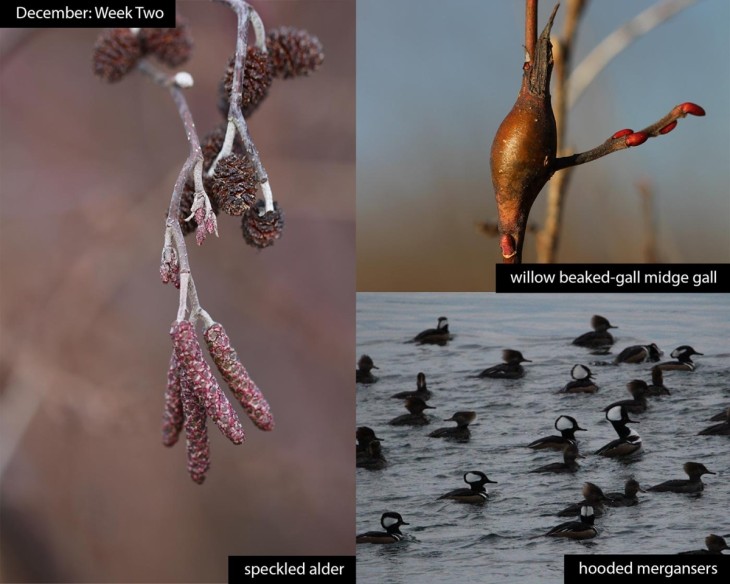This week in the woods, the past year’s fruit and this coming year’s catkins persist on speckled alders, making these diminutive trees stand out. All alder species share the woody, cone-like fruiting structures that remain year-round, even after their seeds have dispersed (see top of photo), but only the speckled alder carries both male and female catkins through the winter. By developing early, the male flowers (at bottom of photo) have a head start on their springtime opening, when the catkins elongate into an even more pendulous shape conducive to wind dispersal. Their pollination happens earlier than many other trees, often in April, and thus avoids the interference of leaves. The smaller female flowers (middle of photo) open simultaneously with the male flowers, but their location above the male flowers discourages self-pollination. These catkins, as well as speckled alder buds and seeds, provide food for goldfinches, grouse, and redpolls, while hares, moose, muskrats, and beavers feed on the twigs and leaves. However, this tree’s main wildlife benefit comes in the form of cover. In the warmer months, the dense thickets alders create on marginal wetland habitat allow woodcock to forage safely in the moist soil around their roots and provide places for alder flycatchers to roost and hunt. For more on the speckled alder, see this species profile from the Northern Woodlands archive.
As Mary Holland explains on her Naturally Curious blog, willows host numerous gall-making insects, including the tiny flies called midges. This pussy willow stem likely houses a willow beaked-gall midge, one of the most common midge species. In the spring, after mating, the adult female lays a single egg in a young bud beginning to expand, the egg hatches, and the larva burrows deeper into the bud. The larva’s burrowing and chemicals from its saliva cause the bud to swell, turn into a gall, and harden over the course of the summer. Especially when made on terminal buds, galls can often exhibit “beaks,” as seen here. The gall shelters the larva through the winter, and the plant tissue provides a constant source of food. The larva will pupate in the spring and emerge as an adult to start the cycle again. The process typically does not cause the tree significant damage.
You might see speckled alders and pussy willows on the edges of the same bodies of water where you’ll find pairs or flocks of hooded mergansers. While these diving ducks once left our region for parts south by mid-November, some now remain later, or even through the winter if sufficient surface area remains free of ice and they can still find aquatic prey. Hoodies are the smallest of the three North American mergansers but also one of the fastest-flying ducks and the most distinctive. The female’s ragged, axe head–like crest gives it a look as jaunty and raffish as the male’s eponymous, white-patched hood. Pairs have formed by now and will breed as early as February.
What have you noticed in the woods this week? Submit a recent photo for possible inclusion in our monthly online Reader Photo Gallery.


